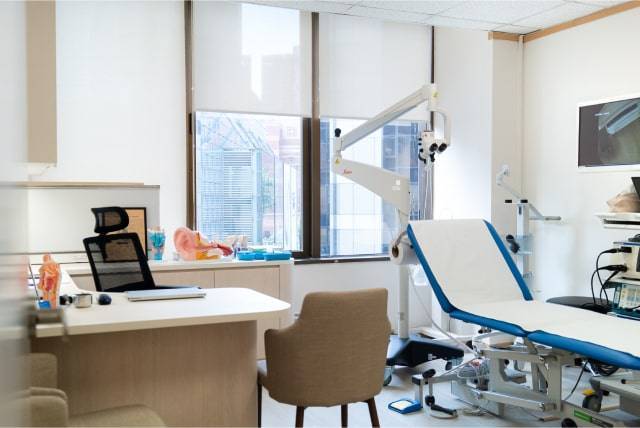
Salivary gland and duct stones, medically known as sialolithiasis, occur when mineral salts accumulate and form calcified masses within the salivary glands or their connecting ducts. This condition is the most common disease of the salivary glands and can lead to blockage of saliva flow, causing pain, swelling, and sometimes infection of the affected gland. The majority of these stones form in the submandibular glands located under the jaw, due to the saliva’s higher calcium content and the upward flow of saliva against gravity. However, stones can also develop in the parotid glands near the ears and, less frequently, in the sublingual glands under the tongue.
Causes and Risk Factors
The exact cause of salivary gland stones is not entirely understood, but several factors can contribute to their formation:
- Dehydration: Insufficient fluid intake reduces saliva production, increasing the risk of stone formation.
- Diet: A diet high in calcium and low in hydration may contribute to stone development.
- Reduced Saliva Flow: Conditions or medications that decrease saliva production can increase the risk.
- Physical Trauma: Injury to the salivary glands or ducts may lead to stone formation.
Symptoms
The symptoms of salivary gland and duct stones can vary depending on the size and location of the stone but commonly include:
- Pain and Swelling: Especially in the affected gland, which may worsen during meals as saliva production increases.
- Dry Mouth: Due to reduced saliva flow.
- Difficulty Swallowing or Opening the Mouth: In severe cases.
- Infection: If saliva flow is blocked, it can lead to bacterial overgrowth and infection, characterised by pus discharge, bad taste in the mouth, and fever.
Diagnosis
Diagnosing salivary gland stones involves a combination of clinical examination and imaging tests:
- Physical Examination: An ENT specialist may palpate the area to locate the stone and assess swelling or tenderness.
- Ultrasound: A non-invasive imaging test that can visualise stones within the glands or ducts.
- Sialography: Involves injecting a dye into the salivary ducts and taking X-rays, although this technique is less commonly used due to the risk of exacerbating symptoms.
- CT Scan: Provides detailed images of the salivary glands and ducts, helpful in complex cases.
Treatment
Treatment options for salivary gland stones aim to remove the stone and restore saliva flow:
- Hydration and Massage: Drinking plenty of water and massaging the affected gland can sometimes help small stones pass naturally.
- Sialogogues: Substances that stimulate saliva production, like sour candies or lemon juice, can increase saliva flow and help dislodge the stone.
- Manual Removal: A healthcare provider may attempt to remove the stone manually if it is located near the duct’s opening.
- Lithotripsy: A non-invasive procedure that uses shock waves to break the stone into smaller pieces that can pass more easily.
- Endoscopic Stone Removal: A minimally invasive technique where a tiny camera and instruments are used to remove the stone without incisions.
- Surgery: In cases where the stone is too large or inaccessible with less invasive methods, surgical removal may be necessary.
Prevention
Preventing the formation of salivary gland stones involves lifestyle changes aimed at maintaining healthy saliva flow:
- Stay Hydrated: Drinking plenty of water throughout the day helps ensure adequate saliva production.
- Good Oral Hygiene: Regular brushing, flossing, and dental check-ups can reduce the risk of infections that might contribute to stone formation.
- Quit Smoking: Tobacco use can decrease saliva flow and contribute to stone formation.
- Dietary Considerations: While no direct link between diet and sialolithiasis has been established, a balanced diet with adequate hydration is recommended.
Conclusion
Salivary gland and duct stones are a relatively common conditions that can lead to significant discomfort and lead to complications if not addressed. Understanding the causes, symptoms, and available treatment options is essential for effective management. With timely intervention, most individuals can achieve complete relief from symptoms and restore normal function to the affected salivary gland. If you suspect you have a salivary gland stone, it’s essential to consult an ear, nose, and throat (ENT) specialist for an accurate assessment and tailored treatment plan.
When should you see an ENT specialist in Singapore?
Please consult an ENT specialist if you are suffering from any ear, nose, or throat symptoms. It is also advisable to visit an ENT doctor if you experience persistent mouth breathing due to a chronic blocked nose or encounter snoring issues.
Dr Ker Liang sees adults and children for general ENT conditions and provides comprehensive management in a broad range of Ear, Nose, and Throat, as well as Head and Neck conditions. In particular, she has a special interest in treating throat and voice conditions, including persistent sore throat, voice issues, snoring, and Obstructive Sleep Apnoea (OSA).
Medical Teaching
Assistant Professor Ker Liang has a passion for teaching and is an Assistant Professor with NUS Yong Loo Lin School of Medicine (YLLSOM). As the NUS-NUH Otolaryngology Department Undergraduate Medical Director, Dr Ker Liang supervises the training of medical students from YLLSOM, NUS. She is actively involved
in the training of postgraduate junior doctors and residents in the Head and Neck Surgery department. She was conferred with an Undergraduate Teaching Award by the National University Health System in 2016 for her outstanding efforts as an Otolaryngology educator.
Medical Teaching
Assistant Professor Ker Liang has a passion for teaching and is an Assistant Professor with NUS Yong Loo Lin School of Medicine (YLLSOM). As the NUS-NUH Otolaryngology Department Undergraduate Medical Director, Dr Ker Liang supervises the training of medical students from YLLSOM, NUS. She is actively involved
in the training of postgraduate junior doctors and residents in the Head and Neck Surgery department. She was conferred with an Undergraduate Teaching Award by the National University Health System in 2016 for her outstanding efforts as an Otolaryngology educator.
Lorem ipsum dolor sit amet, consectetur adipiscing
Lorem ipsum dolor sit amet, consectetur adipiscing elit. Ut elit tellus, luctus nec ullamcorper mattis, pulvinar dapibus leo. Lorem ipsum dolor sit amet, consectetur adipiscing elit. Ut elit tellus, luctus nec ullamcorper mattis, pulvinar dapibus leo.
Lorem ipsum dolor sit amet, consectetur adipiscing
Lorem ipsum dolor sit amet, consectetur adipiscing elit. Ut elit tellus, luctus nec ullamcorper mattis, pulvinar dapibus leo. Lorem ipsum dolor sit amet, consectetur adipiscing elit. Ut elit tellus, luctus nec ullamcorper mattis, pulvinar dapibus leo.
Lorem ipsum dolor sit amet, consectetur adipiscing
Lorem ipsum dolor sit amet, consectetur adipiscing elit. Ut elit tellus, luctus nec ullamcorper mattis, pulvinar dapibus leo. Lorem ipsum dolor sit amet, consectetur adipiscing elit. Ut elit tellus, luctus nec ullamcorper mattis, pulvinar dapibus leo.
Lorem ipsum dolor sit amet, consectetur adipiscing
Lorem ipsum dolor sit amet, consectetur adipiscing elit. Ut elit tellus, luctus nec ullamcorper mattis, pulvinar dapibus leo. Lorem ipsum dolor sit amet, consectetur adipiscing elit. Ut elit tellus, luctus nec ullamcorper mattis, pulvinar dapibus leo.
Lorem ipsum dolor sit amet, consectetur adipiscing
Lorem ipsum dolor sit amet, consectetur adipiscing elit. Ut elit tellus, luctus nec ullamcorper mattis, pulvinar dapibus leo. Lorem ipsum dolor sit amet, consectetur adipiscing elit. Ut elit tellus, luctus nec ullamcorper mattis, pulvinar dapibus leo.



